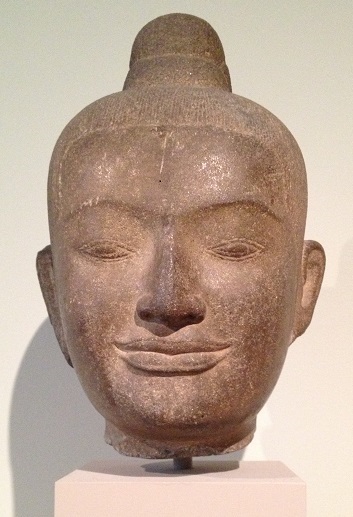
Unknown
Cambodian, Kmer
Head of Lokesvara, 13th c. CE
sandstone
18 1/8 in.
SBMA, Gift of Wright S. Ludington in memory of Charles Henry Ludington
1983.27.1
RESEARCH PAPER
PERIOD
This head of Lokesvara (or Avalokitesvara in India; Kuan-Yin in China) is from the last phase of the Classic Period of Khmer Art, and more specifically of the Bayon period. The name of this period and style comes from the temple-mountain of the Bayon situated in the center of Angkor Thom, “the Great Capital.” This was to be the last of the temples for the “linga” of the king, because of the popularity of Theravedic Buddhism overcoming the trend of Hinduism. The following kings after Jayavarman no longer believed in their divinity to erect monuments to themselves as god-kings.
Jayavarman VII, the famous and arrogant king of this period, had himself represented in his mountain temple, the Bayon, not as Shiva or Vishnu, but as “Buddha the King.” He dedicated himself to Lokesvara still more than to Buddha. He had religious themes carved on a colossal scale for all to see, not just for himself and the priests. He built several temples with “Towers of the Four Faces” as well as gigantic heads crowning the entrances to his capital. These faces are of Lokesvara or other Bodhisattvas. There was also a sanctuary dedicated to Lokesvara in the center of the lake, whose water was used for ritual ablution. The king also erected temple monasteries, one of which housed the statue of his father with the attributes of Lokesvara.
CONTENT
Avalokitesvara was a popular savior or Bodhisattva. His head is represented in Khmer art wearing a “jata” or stylized hair braided in a round chignon. This was usually marked with a small “Amithaba” or Buddha; our sculpture does not have this mark. The head in our museum has the characteristic almond-shaped eyes, thick nose, and thick-lipped mouth with the smile of Khmer features. The Lokesvaras of the Bayon are probably to be interpreted as ideal portraits of the king Jayavarman as an incarnation of this Bodhisattva.
STYLE
In the Bayon style, figures are often poorly carved and clumsy, although the faces seem often to be portraits and to be sensitively done. They often show emotions such as pity and compassion. The faces of Lokesvara on the Bayon towers are meditating and smiling, creating an overpowering atmosphere. “The Smile of the Bayon,” sweet and unworldly, which “points to the search for an ideal of beauty and peace” seems to typify that style. Rowland in “Art and Architecture of India” says that “This suggestion of inner beatitude becomes a cliché of all later Khmer sculpture.”
In the Bayon period the idols were not carved with jewelry. This is because the temple servants decked them with jewels and silk. A pectoral was hung on the neck and perhaps a diadem on the forehead.
USES
For the king of the Bayon, Lokesvara was the favored guardian. Since the Hindu gods had not protected the Khmers from their enemies, they were now turning to Buddhism to protect them from Thai invasions. Buddhism was not popular with the masses.
The art of the Bayon is a secular style for the people, not just for the king and his priests. At this time there was a great demand for quantities of idols, and this is why the quality of carving was uneven. The artists were overwhelmed with commission s from people seeking private images for their chapels. The king extended the privilege of votive statues to his family, his servants, and soon to this whole people. Sculpture was everywhere in the capital.
- Research from the Santa Barbara Museum of Art Docent Council files, author unknown
